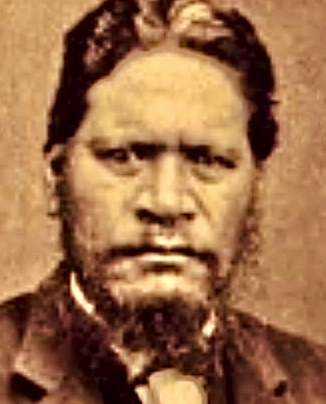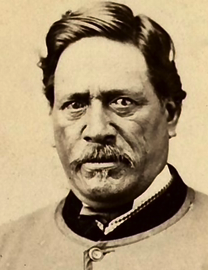These are Erenora's
original lyrics, according to Lucy Jacob, Erenora's
granddaughter, who accompanied her to hui.
Notes
a.
Taku
poi. Her swinging poi represents
her emotional attraction towards certain men, an attraction
kept well under control by her hand holding its string.
b. Otairi, Inland Patea and Onetapu are all significant tribal boundaries. Otairi is a settlement on a river flat halfway up the Turakina river valley. Erenora's family home was near the mouth of the Rangitikei River, and the old track Kotae-iri (raised riverflats) took the route from her home up the river on the raised riverflats used by today's State Highway One from Bulls to Hunterville, then nor-east to Otairi and across a saddle to the Mangamahu to join the track Upokongaro up the ridge to Karioi (my childhood was at Mangamahu and I have traversed all these tracks. Many of them became packhorse tracks for colonial settlers, then farm roads) c.
Mokai
Patea. The route from Karioi to Lake Taupo is
directly north across the Rangipo Desert, while the Mokai
Patea region, centered at Moawhango, is 30 km east! However
the Ngati Tama people around Moawhango are associated with
Tuwharetoa and Ngati Rakawa.
d. Onetapu, the Forbidden Sands, is the site of a boundary pou, Ma-pou-riki, or Te Roro-o-Tai-ariki. This place commemorates where Tai-te-ariki got his brains (roro) battered out in about 1300 AD. Tai was the son of Whiro, whose people settled the Murimotu area south of Mt Ruapehu. More here. Tai became an ariki in Rarotonga and got killed in a boundary dispute with Maori from south of Taupo. It was too cold to live up on the Rangipo desert, but the Taupo people had been harvesting and preserving some of the innumerable kiwi, weka, moa, titi, kakapo etc on the Murimotu tussock lands (Army Training Area) south of Onetapu for winter food. More here.  e. Ranga is borrowed from the English word 'run'. 1.
Te
Rohu was the daughter of Te Heuheu Tukino
and was afflicted with leprosy.
Te Rerehau had been abandoned by her
husband. Apparently these were two of the women who
had criticized Erenora's sexual freedom.
2. Ruahine was the granddaughter of Turi, captain of the Aotea waka. She was regarded as a very wise woman. 3. Hapai ewe ki nga whenua is a retort for the allegation that she had not disposed of her afterbirth before she had taken another man. Her use of the word 'whenua' is clever wordplay, as it can mean both the lands where high-ranking Ngati Raukawa men have courted her, and the high-ranking men who could have potentially produced more afterbirths for her. 4. Horohoro. Erenora was of Ngati Raukawa, and Horohoro is a plateau south-west of Rotorua.It was settled by Ngati Wairangi, Ngati Whaita and Ngati Tuara, all of them her sub-tribes. 5. Tarawera is just above Rotorua. The tribes there were Ngati Taoi and Tuhourangi. 6. Te Hemahemaa was chief of the Tuhourangi tribe. 7. Parehokotoru, Te Apoapo, Ngatoro. I think they were 3 notable Rotorua women who had also criticized Erenora. 8. Tupaea was a great Ngai Te Rangi chief at Tauranga. 9. Hapai and Taraia were Hauraki high chiefs. 10. Tauaiti was of the Ngati Raukawa and Waikato tribes. 11.
Mahurangi was a settle in the Hauraki district.
12. Te Aohau and Tiaho. These two Hauraki chiefs also belonged to Ngati Raukawa. 13. Te Paea was the daughter of King Potatau. Verses added later These
two similar versions have apparently come from Ngati
Kahungunu sources.
The verses above are slightly changed in the Kahungunu
version here.
Elsdon
Best collected a Tuhoe version that began with this
prelude.
 15.
Karaitiana Takamoana was a veteran of the
Musket Wars and the East Coast Land Wars, the founding
father of the modern Ngāti Kahungunu iwi, and MP for Eastern
Maori from 1871 until his death in 1879. 15.
Karaitiana Takamoana was a veteran of the
Musket Wars and the East Coast Land Wars, the founding
father of the modern Ngāti Kahungunu iwi, and MP for Eastern
Maori from 1871 until his death in 1879.16. Porangahau is on the east coast, directly opposite Erenora's west coast family home. I could find no details about the mysterious Pare. Nor could I figure out what this section refers to. Was it Karaitiana's home village? If you know, email me, and I'll add the details to this section. 17. Wiremu Tako Ngātata,  (Te Āti Awa, Ngāti Ruanui) a.k.a. Wī Tako, was born c.1800 at
Pukeariki pā, Taranaki. In the 1830s his people migrated south
to Kumutoto, now the Wellington wharf area. He was involved in
a highly dubious transaction through which the NZ Company
claimed to have purchased the whole region. He became a
Methodist, then a Catholic, and regularly spoke out against
warlike talk.
(Te Āti Awa, Ngāti Ruanui) a.k.a. Wī Tako, was born c.1800 at
Pukeariki pā, Taranaki. In the 1830s his people migrated south
to Kumutoto, now the Wellington wharf area. He was involved in
a highly dubious transaction through which the NZ Company
claimed to have purchased the whole region. He became a
Methodist, then a Catholic, and regularly spoke out against
warlike talk. In the 1850s he moved to a 17-roomed house at Taita and built an elaborately carved storehouse called Nuku Tewhatewha to show his support for a Māori king. As wars between the Maori King and the Colonists broke out, Wī Tako tried to fill the role of mediator, and he began shuttling back and forth from Taita to a house at Horotiu (just north of Hamilton) for discussions with the King. In 1872 he was appointed to the Legislative Council, one of the first Māori to be a member. He died in 1887. Erenora's fatherNepia Taratoa
(c.1797 - 1867) was from the Ngati Raukawa tribe and a
relative of Te Rauparaha. He settled in the Rangitikei area
after migrating south with Te Whatanui and others in the early
1800s. He gained control over his domain through battles and
negotiations, including a strategic marriage to the local
Ngati Apa chieftainess, Te Pikinga, that prevented future
conflicts. Despite occasional disputes, Taratoa remained a
prominent chief. He resided with his second wife Pareautohe
and their children Pataka, Nepia, Erenora and Atareti on the
south side of the Rangitikei River at Maramahoea, halfway
between Tangimoana and today's SH1. More
here
Erenora Trask Erenora was born in 1820 and in
her 20s she apparently attended the school of George Duncan, a
Presbyterian minister at Te Awahou (Foxton).
In 1856 Thomas Ulysses Cook opened a hotel at Te Awahou. He had a Maori wife, Meretini, a granddaughter of Te Rauparaha, so the hotel was a great meeting place for the Maori people for both trading and recreation. Mr Cook employed a baker there, George Enoch Trask (Tarahi) who was born in Somerset, England in 1834. In about 1856, through her liaison with the 21-year-old George Trask, the 36-year-old Erenora had a son whom she named Winiata Pataka Trask, the founder of the well-respected Winiata family of Horowhenua. Her father refused to allow Erenora to formally marry 'Tarahi,' but they had another child, Hinepuororangi Trask, and then in 1864, when Erenora was in her 40s, the 30-year-old Trask formally married the 20-year old Sarah Ann Barnett (b. 1844) who gave him 12 more children.
The highly talented Puhiwahine (Maniopoto, Tuwharetoa) was born in Taumarunui just four years before Erenora, and had romances similar to Erenora in her teenage years and twenties before marrying Germany-born John Gotty, (Johann Goethe) a Whanganui hotel-keeper. Over at the Putiki marae, she kept the women there entertained with her singing. This song takes us on a similar journey to Erenora's, but it is a more light-hearted song about past escapades and erotic day-dreams. Read more about her here.
You can find a lot more about this song by clicking here Published by John Archer on the NZFS website August 2023 |

